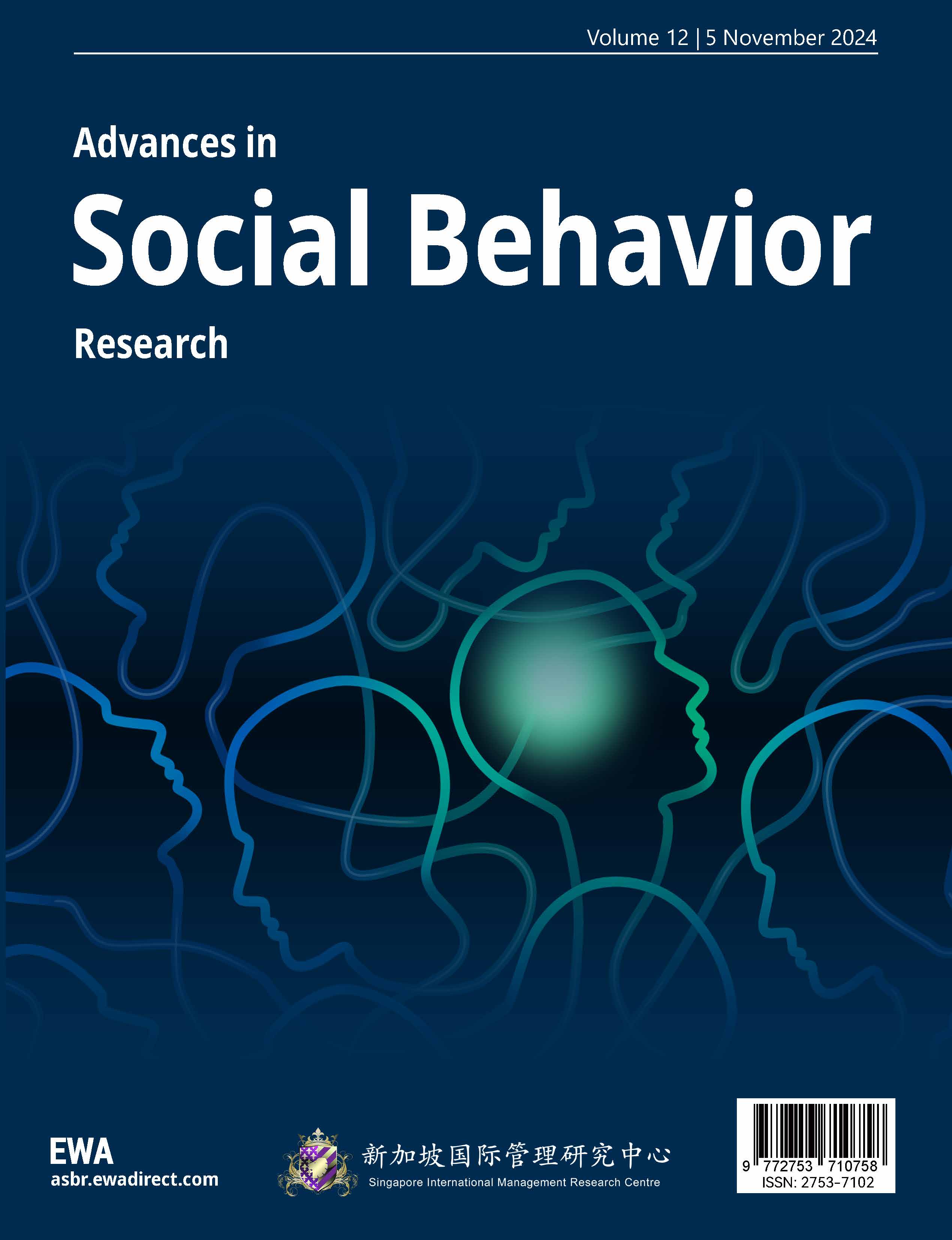1. Introduction
Adolescence represents a pivotal stage marked by neurobiological plasticity and heightened socioemotional sensitivity, during which individuals develop adaptive or maladaptive strategies to navigate stressors [1]. Coping strategies, defined as cognitive and behavioral efforts to manage internal or external demands perceived as exceeding personal resources, play a central role in shaping Emotional Regulation (ER) outcomes [2]. Among these strategies, 'cognitive reappraisal' (reinterpreting emotional stimuli to alter their impact) and 'expressive suppression' (inhibiting outward emotional expressions) are two well-documented ER mechanisms with distinct neural and psychological correlates [3]. Cognitive reappraisal engages prefrontal cortical regions (e.g., medial orbitofrontal cortex) to downregulate amygdala activity, thereby reducing subjective negative affect and sympathetic arousal, whereas expressive suppression amplifies physiological reactivity (e.g., increased heart rate) despite masking emotional behaviors, potentially depleting cognitive resources and impairing social functioning [4]. The Emotion Regulation Questionnaire (ERQ), developed by Gross, is widely adopted for its robust psychometric properties; its Chinese version demonstrates high reliability and validity in adolescent populations, making it suitable for cross-cultural ER research [5].
Parallel to these ER processes, youth subcultures like Anime, Comics, and Games (ACG) have emerged as critical arenas for adolescent identity exploration and emotional coping. Approximately 35% of adolescents in East Asia engage in ACG-related activities annually, with 'cosplay' (costume role-playing) and 'conventions' serving as cornerstone practices [6]. These activities facilitate ER through multiple mechanisms. By embodying fictional characters, adolescents engage in a process known as identity experimentation, which allows them to temporarily dissociate from real-world stressors and reframe self-perceived inadequacies through cognitive reappraisal [7]. At the same time, conventions offer communal spaces where shared interests foster a sense of social belonging and peer acceptance, thereby reducing the need for expressive suppression in socially validating environments [8]. Additionally, immersive role-playing may function as a form of escapism, providing short-term emotional relief through avoidant coping strategies, though it also carries the risk of prolonged disengagement from real-life issues [9].
However, the duality of these effects remains underexplored. While cosplay enhances self-efficacy and social connectivity for many, excessive reliance on fictional personas may exacerbate emotional dysregulation, particularly among adolescents predisposed to maladaptive ER strategies [10]. For instance, conformity to idealized character traits could amplify social comparison pressures, triggering anxiety or depressive symptoms when the real self conflicts with the character identity [11]. Grounded in 'Social Identity Theory', which posits that group membership shapes self-concept and emotional well-being, this study investigates how ACG participation modulates ER strategies in adolescents [12].
The ERQ's focus on cognitive reappraisal and expressive suppression aligns with ACG culture's dual ER pathways: creative reinterpretation (reappraisal) and emotional restraint (suppression) during social interactions. Prior studies on analogous subcultures (e.g., gaming communities) reveal that group norms often valorize emotional control (e.g., suppressing frustration during competitive play), paralleling expressive suppression's behavioral outcomes [13]. Conversely, narrative engagement in anime or comics frequently necessitates cognitive reframing of complex themes (e.g., moral ambiguity), mirroring reappraisal processes [14].
In this study, the author investigates how different types of ACG participation, such as Cosplay Only, Convention Attendance Only, and combined involvement, relate to adolescents’ use of cognitive reappraisal and expressive suppression. By integrating emotion regulation theory with social identity theory, this research highlights the dual role of ACG subcultures in shaping emotional coping. The findings aim to inform culturally sensitive mental health practices by illustrating how popular youth leisure spaces can both support and constrain adaptive emotional development.
2. Method
2.1. Participants
Participants were recruited through volunteer sampling, comprising 204 Chinese adolescents aged 13-18 years (M = 16.0, SD = 1.62). After exclusion of invalid responses (e.g., incomplete or patterned answers), the final sample consisted of 204 individuals (40.7% male, 59.3% female). Recruitment targeted Anime, Comics, and Games (ACG) interest communities via social media platforms (Weibo and WeChat). Digital posters and questionnaire links explicitly stated the study’s purpose and the principle of voluntary participation. No direct compensation was offered; however, participants could enter a raffle for three ¥50 e-coupons following questionnaire completion.
2.2. Measures
2.2.1. Cosplay engagement types
Participation was categorized into three mutually exclusive groups based on self-reported activities over the preceding year. The Cosplay Only (CP-Only) group included adolescents who engaged in private or public cosplay without attending conventions. The Convention Attendance Only (CN-Only) group comprised those who attended ACG conventions but did not participate in cosplay. The Combined Engagement (CP+CN) group consisted of individuals involved in both cosplay and convention activities concurrently.
2.2.2. Emotion Regulation Questionnaire (ERQ)
The 10-item Emotion Regulation Questionnaire (ERQ), developed by Gross and John in 2003, assessed two emotion regulation strategies using a 7-point Likert scale ranging from 1 (strongly disagree) to 7 (strongly agree). Cognitive reappraisal was measured with six items that evaluated the tendency to regulate emotions by reinterpreting situations, such as the statement "I control my emotions by changing how I think about situations." Expressive suppression was assessed with four items that captured the inclination to inhibit emotional expression, exemplified by the item "I keep my emotions to myself." Subscale scores were calculated as the mean of the item ratings, with higher scores indicating more frequent use of the respective strategy. The internal consistency of the two subscales was acceptable, with Cronbach’s
2.2.3. Demographic and engagement variables
Age, gender, and ACG engagement frequency (5-point scale: 1 = Never to 5 = Weekly) were collected. The online questionnaire was hosted on Wenjuanxing (https://www.wjx.cn/vm/eJVnBO5.aspx#) and remained accessible for a 21-day data collection period.
2.3. Statistical analysis
All analyses were conducted using SPSS 26.0. Group differences in ERQ subscales across cosplay engagement types were examined via one-way ANOVA, with Tukey’s HSD post hoc tests applied upon significant omnibus results. Homogeneity of variance was verified using Levene’s test (p > 0.10 for all comparisons). Linear regression analyses evaluated associations between cosplay frequency (independent variable) and ERQ subscale scores (dependent variables), with residual plots confirming normality and homoscedasticity assumptions.
3. Results
3.1. Participant characteristics
The sample included 204 participants aged between 13 and 18 years (M = 16.00, SD = 1.62). Of the total sample, 40.7% were male and 59.3% were female. Participants were categorized into three distinct groups based on their engagement in cosplay and convention activities: Cosplay Only (CP-Only), Convention Only (CN-Only), and Cosplay and Convention (CP+CN). As shown in Table 1, CP-Only refers to participants who engage in cosplay but do not attend conventions (n = 46), CN-Only refers to participants who attend conventions but do not engage in cosplay (n = 75), and CP+CN refers to participants who engage in both cosplay and attend conventions (n = 83).
|
Group |
N |
Mean Age (SD) |
% Male |
% Female |
|
CP-Only |
46 |
15.83 (1.45) |
52.2% |
47.8% |
|
CN-Only |
75 |
15.79 (1.37) |
50.7% |
49.3% |
|
CP+CN |
83 |
16.28 (1.78) |
25.3% |
74.7% |
|
Total |
204 |
16.00 (1.62) |
40.7% |
59.3% |
3.2. Cosplay and convention engagement frequency
To assess differences in cosplay engagement frequency among the three participant groups (CP-Only, CN-Only, CP+CN), a one-way ANOVA was conducted, and the results are shown in Table 2. The analysis revealed statistically significant differences between groups, F(2, 201) = 11.237, p < 0.001, with a moderate effect size (η² = 0.101). Post hoc Tukey HSD tests indicated that the CP+CN group reported significantly lower engagement frequency (M = 3.76, SD = 0.774) compared to both the CP-Only group (M = 4.28, SD = 0.779, p < 0.001) and the CN-Only group (M = 4.25, SD = 0.699, p < 0.001) (see details in Table 2). No significant difference was found between the CP-Only and CN-Only groups (p = 0.405). These results suggest that participants engaged in both cosplay and conventions exhibited distinct engagement patterns compared to those focused solely on one activity.
|
Group |
N |
Mean |
Std. Deviation |
95% Confidence Interval |
|
CP-Only |
46 |
4.28 |
0.779 |
[4.05, 4.51] |
|
CN-Only |
75 |
4.25 |
0.699 |
[4.09, 4.41] |
|
CP+CN |
83 |
3.76 |
0.774 |
[3.59, 3.93] |
3.3. Differences in emotion regulation scores by cosplay and convention engagement
To examine whether cosplay and convention engagement types were associated with differences in emotion regulation, a one-way Analysis of Variance (ANOVA) was conducted to compare Cognitive Reappraisal and Expressive Suppression scores across the three groups (CP-Only, CN-Only, and CP+CN).
3.4. Cognitive reappraisal scores
The ANOVA results in Table 3 indicated a significant difference in Cognitive Reappraisal scores among the three groups, F(2, 201) = 18.235, p < 0.001, with a moderate effect size (η² = 0.154). Post hoc Tukey HSD tests revealed that participants in the CP-Only group had significantly higher Cognitive Reappraisal scores compared to the CP+CN group (p < 0.001). No significant difference was observed between the CP-Only and CN-Only groups (p = 0.405).
|
Group (I) |
Group (J) |
Mean Difference (I-J) |
p-value |
|
CP-Only |
CN-Only |
1.047 |
0.405 |
|
CP-Only |
CP+CN |
4.304 |
< .001 |
|
CN-Only |
CP+CN |
3.257 |
< .001 |
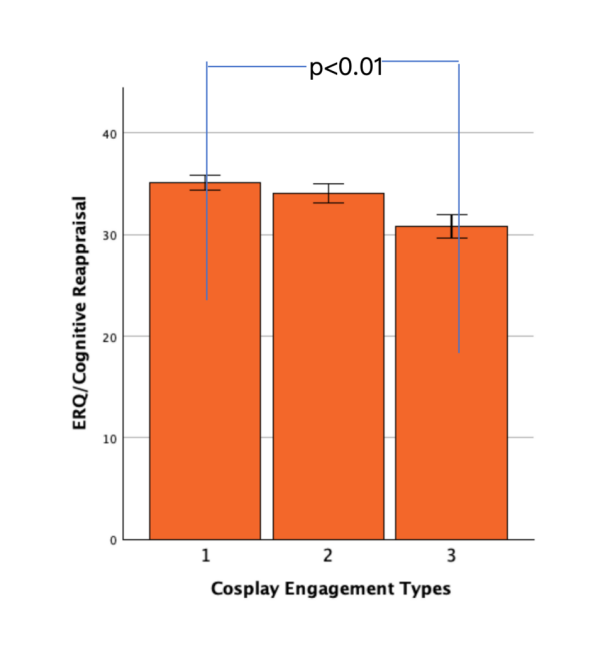
Figure 1 illustrates the CP-Only group had the highest cognitive reappraisal scores, while the CP+CN group scored the lowest, which means the dual engagement in cosplay and conventions is associated with reduced cognitive reappraisal.
3.5. Expressive suppression scores
The ANOVA results for Expressive Suppression scores in Table 4 also showed a significant difference among the three groups, F(2, 201) = 37.596, p < 0.001, with a large effect size (η² = 0.272). Post hoc Tukey HSD tests indicated that participants in the CP-Only group had significantly higher Expressive Suppression scores compared to the CP+CN group (p < 0.001). Similarly, the CN-Only group had significantly higher Expressive Suppression scores compared to the CP+CN group (p < 0.001). No significant difference was found between the CP-Only and CN-Only groups (p = 0.837).
|
Group (I) |
Group (J) |
Mean Difference (I-J) |
p-value |
|
CP-Only |
CN-Only |
0.346 |
0.837 |
|
CP-Only |
CP+CN |
4.215 |
< .001 |
|
CN-Only |
CP+CN |
3.869 |
< .001 |
Figure 2 shows the mean Expressive Suppression scores across the three cosplay engagement types. To examine the predictive relationship between cosplay participation frequency and emotion regulation scores, two separate linear regression analyses were conducted, with Cognitive Reappraisal and Expressive Suppression as the dependent variables. Only participants from the CP-Only and CP+CN groups (n=129) were included in the analysis, as the CN-Only group does not engage in cosplay.
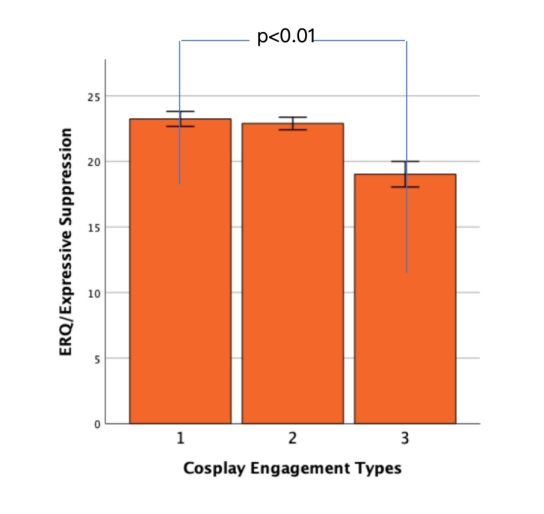
3.6. Cognitive reappraisal
A linear regression model was conducted to predict Cognitive Reappraisal scores based on cosplay participation frequency. The overall model was statistically significant, F(1, 127) = 16.370, p < 0.001, indicating that cosplay frequency significantly predicted Cognitive Reappraisal scores. The coefficient of determination (R²) was 0.114, suggesting that cosplay participation frequency accounted for approximately 11.4% of the variance in Cognitive Reappraisal scores.
The regression coefficients indicated that the intercept was 24.287 (SE = 2.026, p < 0.001), and the coefficient for cosplay frequency was 2.035 (SE = 0.503, p < 0.001). For every one-unit increase in cosplay participation frequency, Cognitive Reappraisal scores increased by approximately 2.035 points. The 95% confidence interval for the coefficient ranged from 1.040 to 3.031, indicating a precise and statistically significant effect (Figure 3).
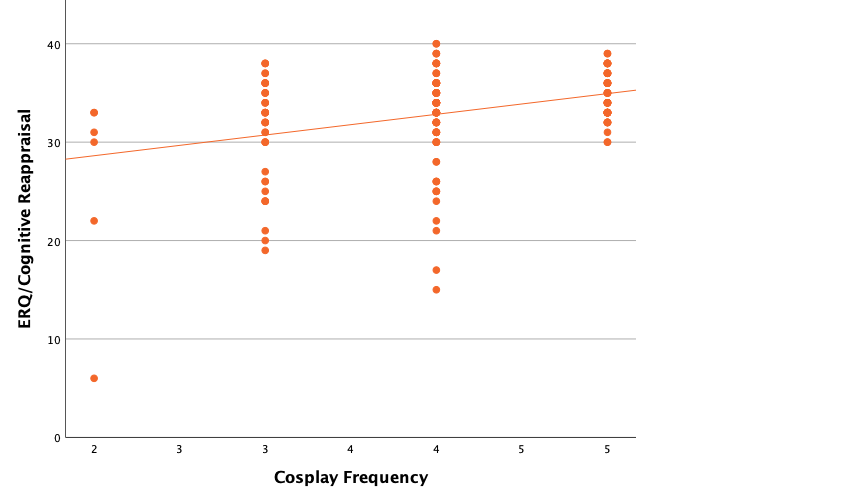
3.7. Expressive suppression
A second linear regression was conducted to examine the relationship between cosplay participation frequency and Expressive Suppression scores. The overall model was statistically significant, F(1, 127) = 20.625, p < 0.001, indicating that cosplay frequency significantly predicted Expressive Suppression scores. The coefficient of determination (R²) was 0.140, suggesting that cosplay frequency accounted for approximately 14.0% of the variance in Expressive Suppression scores.
The regression coefficients showed that the intercept was 12.801 (SE = 1.737, p < 0.001), and the coefficient for cosplay frequency was 1.958 (SE = 0.431, p < 0.001). For every one-unit increase in cosplay participation frequency, Expressive Suppression scores increased by approximately 1.958 points. The 95% confidence interval for the coefficient ranged from 1.105 to 2.811 (Figure 4).
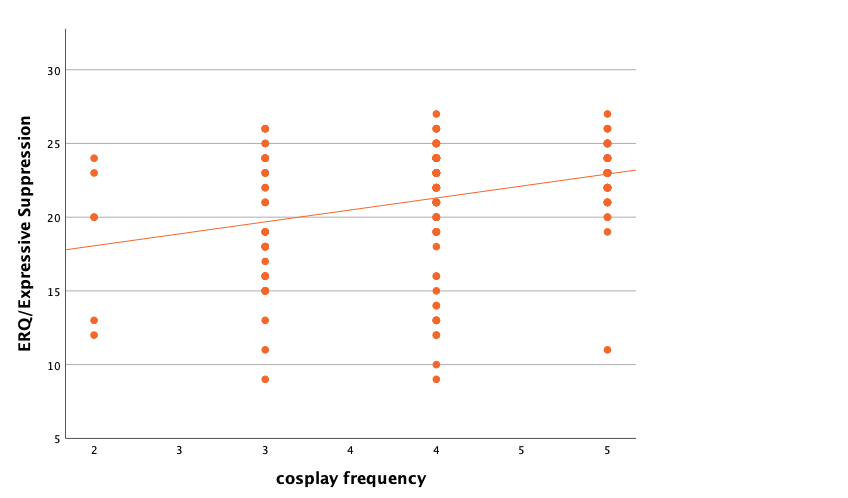
4. Discussion
The findings of this study reveal nuanced relationships between adolescents’ engagement in ACG subcultural activities and their emotion regulation strategies, particularly in the context of cognitive reappraisal and expressive suppression. The 'CP+CN group' (participants engaging in both cosplay and conventions) exhibited distinct patterns compared to isolated engagement groups, suggesting that subcultural immersion may simultaneously foster emotional authenticity and impose cognitive demands that constrain adaptive regulation. These results align with emerging perspectives on the dual role of leisure activities in emotional development, where communal belonging and performance pressures create a dynamic interplay between adaptive and maladaptive strategies [15].
The reduced cognitive reappraisal scores in the CP+CN group contrast with prior studies emphasizing the benefits of cognitive strategies in social settings [16]. This discrepancy may stem from the unique pressures of public role-playing, where real-time social evaluation shifts focus from reflective reappraisal to behavioral adaptation—a phenomenon observed in neurobiological studies linking prefrontal-limbic interactions to performance anxiety [17]. Specifically, the heightened demand for maintaining fictional personas in conventions might deplete cognitive resources, redirecting neural activity from prefrontal regions involved in reappraisal to limbic areas mediating immediate emotional responses [18]. Such a mechanism is supported by recent findings on visual cortex involvement in emotion regulation, where sensory processing regions unexpectedly modulate depressive behaviors through thalamic pathways [19]. This underscores the need to reevaluate traditional models of emotion regulation that prioritize limbic-centric networks.
Conversely, the CP+CN group’s lower expressive suppression scores align with theories positing that subcultural communities act as "safe spaces" for emotional authenticity [20]. Shared norms and acceptance of non-conventional self-expression may reduce the need to inhibit emotions, a pattern documented in therapeutic communities and online support groups [21]. This effect is further amplified by the gender composition of the CP+CN group (74.7% female), as cultural studies highlight gendered differences in emotion expression, with females often exhibiting lower suppression tendencies in collectivist contexts [22]. However, the lack of suppression reduction in the CN-Only group suggests that passive convention attendance lacks the identity experimentation inherent in active cosplay, which may be critical for fostering emotional openness [23].
The regression analysis, showing that increased cosplay frequency predicted both higher reappraisal and suppression scores, introduces a paradox: frequent engagement may cultivate situational flexibility, enabling individuals to toggle between adaptive and maladaptive strategies depending on context [24]. This mirrors occupational studies on "emotional labor," where workers alternate between deep acting (reappraisal) and surface acting (suppression) to meet role demands [25]. In ACG contexts, private cosplay might allow for reflective reappraisal, while public performances necessitate suppression to maintain character consistency—a duality that warrants further exploration through longitudinal designs.
Future research should prioritize interdisciplinary approaches to unravel the complex interplay between ACG subcultural engagement and emotion regulation. Neurobiological investigations using fMRI could map prefrontal-limbic dynamics during cosplay activities, particularly contrasting private and public settings, while recent advances in visual cortex research suggest sensory regions may play underappreciated roles in emotion modulation [19]. Cross-cultural comparisons with Western cohorts are critical to test whether individualistic norms alter suppression patterns observed in East Asian collectivist contexts [26]. Intervention studies could integrate cognitive reappraisal training into cosplay workshops, leveraging self-distancing techniques to mitigate performance-related cognitive depletion, while longitudinal designs tracking adolescents’ transitions between engagement types may clarify whether subcultural immersion cultivates adaptive strategies or attracts predisposed individuals [27, 28].
5. Conclusion
This study positions ACG subcultures as dual-edged emotional ecosystems: they reduce expressive suppression through communal belonging yet risk depleting cognitive resources under public performance demands. By bridging social identity theory with neurobiological insights, it underscores the need for context-sensitive mental health interventions that harmonize subcultural engagement with psychological well-being. Future work must adopt cross-cultural, longitudinal, and neuroimaging frameworks to disentangle these dynamics, ultimately transforming leisure spaces into laboratories for adaptive emotional learning.
Acknowledgements
The author expresses sincere gratitude to Wang Guanzhou for his expert guidance and critical revision of this manuscript. Special thanks are extended to all participants who contributed their time and insights. This research received no specific grant from funding agencies in the public, commercial, or not-for-profit sectors.
References
[1]. Kanacri, B. P. L., Pastorelli, C., Eisenberg, N., Zuffianò, A., Castellani, V., & Caprara, G. V. (2014). Trajectories of prosocial behavior from adolescence to early adulthood: Associations with personality change.Journal of Adolescence, 37(5), 701–713.
[2]. Lazarus, R. S., & Folkman, S. (1984). Stress, appraisal, and coping. Springer Publishing Company.
[3]. Gross, J. J. (1998). The emerging field of emotion regulation: An integrative review.Review of General Psychology, 2(3), 271-299.
[4]. Ochsner, K. N., & Gross, J. J. (2005). The cognitive control of emotion.Trends in Cognitive Sciences, 9(5), 242–249.
[5]. Wang, D., Yuan, B., Han, H., & Wang, C. (2022). Validity and reliability of emotion regulation questionnaire (ERQ) in Chinese rural-to-urban migrant adolescents and young adults.Current Psychology, 41(4), 2346–2353.
[6]. Fong, W., Rockett, R. J., Tam, K. K.-G., Nguyen, T., Sim, E. M., Tay, E., ... Watt, A. E. (2024). Targeted culture-independent sequencing identifies the emergence of macrolide-resistant Bordetella pertussis in Australia. medRxiv. https: //doi.org/10.1101/2024.12.19.24319368
[7]. Baudin, J. S. P., & Chavez, M. L. L. (2025). A narrative inquiry into self-discovery, social, and emotional development among young adults through cosplay.International Journal of Social Science and Education Research Studies,5(1), 58-69
[8]. Tajfel, H., & Turner, J. (2004). The social identity theory of intergroup behavior. In J. T. Jost & J. Sidanius (Eds.),Political psychology: Key readings(pp. 276–293). Psychology Press.
[9]. Snodgrass, J. G., Lacy, M. G., Dengah II, H. F., Eisenhauer, S., Batchelder, G., & Cookson, R. J. (2014). A vacation from your mind: Problematic online gaming is a stress response.Computers in Human Behavior, 38, 248–260.
[10]. Przybylski, A. K., & Weinstein, N. (2017). A large-scale test of the Goldilocks hypothesis: Quantifying the relations between digital-screen use and the mental well-being of adolescents.Psychological Science,28(2), 204–215.
[11]. Festinger, L. (1957). Social comparison theory.Selective Exposure Theory, 16(401), 3.
[12]. Turner, J. C., & Oakes, P. J. (1986). The significance of the social identity concept for social psychology with reference to individualism, interactionism and social influence.British Journal of Social Psychology, 25(3), 237–252.
[13]. Kowert, R., Domahidi, E., Festl, R., & Quandt, T. (2014). Social gaming, lonely life? The impact of digital game play on adolescents’ social circles.Computers in Human Behavior, 36, 385–390.
[14]. Jenkins, H. (2018). Fandom, negotiation, and participatory culture.In A companion to media fandom and fan studies(pp. 11–26).
[15]. Aldao, A., Nolen-Hoeksema, S., & Schweizer, S. (2010). Emotion-regulation strategies across psychopathology: A meta-analytic review.Clinical Psychology Review, 30(2), 217–237.
[16]. Gross, J. J., & John, O. P. (2003). Individual differences in two emotion regulation processes: Implications for affect, relationships, and well-being.Journal of Personality and Social Psychology, 85(2), 348–362.
[17]. Zhao, J., Mo, L., Bi, R., He, Z., Chen, Y., Xu, F., ... Zhang, D. (2021). The VLPFC versus the DLPFC in downregulating social pain using reappraisal and distraction strategies.Journal of Neuroscience, 41(6), 1331–1339.
[18]. Suthana, N., Ekstrom, A. D., Yassa, M. A., & Stark, C. (2021). Pattern separation in the human hippocampus: Response to Quiroga. Trends inCognitive Sciences, 25(6), 423–424.
[19]. Tang, J., LeBel, A., Jain, S., & Huth, A. G. (2023). Semantic reconstruction of continuous language from non-invasive brain recordings.Nature Neuroscience, 26(5), 858–866.
[20]. Rubin, K. H., Coplan, R. J., & Bowker, J. C. (2009). Social withdrawal in childhood.Annual Review of Psychology, 60(1), 141–171.
[21]. Jetten, J., Haslam, C., & Alexander, S. H. (2012). The social cure: Identity, health and well-being. Psychology Press.
[22]. Al-Shawaf, L., Conroy-Beam, D., Asao, K., & Buss, D. M. (2016). Human emotions: An evolutionary psychological perspective.Emotion Review, 8(2), 173–186.
[23]. Cavicchi, D. (2018). Foundational discourses of fandom.In A companion to media fandom and fan studies(pp. 27–46).
[24]. Grandey, A. A. (2000). Emotional regulation in the workplace: A new way to conceptualize emotional labor.Journal of Occupational Health Psychology, 5(1), 95–110.
[25]. Brotheridge, C. M., & Grandey, A. A. (2002). Emotional labor and burnout: Comparing two perspectives of "people work."Journal of Vocational Behavior, 60(1), 17–39.
[26]. He, Z., Muhlert, N., & Elliott, R. (2021). Emotion regulation of social exclusion: A cross-cultural study.Humanities and Social Sciences Communications, 8(1), 1–7.
[27]. Kross, E., & Ayduk, O. (2017). Self-distancing: Theory, research, and current directions.In Advances in experimental social psychology(Vol. 55, pp. 81–136). Elsevier.
[28]. Lorenz-Spreen, P., Lewandowsky, S., Sunstein, C. R., & Hertwig, R. (2020). How behavioural sciences can promote truth, autonomy and democratic discourse online.Nature Human Behaviour, 4(11), 1102–1109.
Cite this article
Chen,Y. (2025). A study on the mechanism of comic conventions and cosplay participation in expressing negative emotions among middle and high school students. Advances in Social Behavior Research,16(8),71-78.
Data availability
The datasets used and/or analyzed during the current study will be available from the authors upon reasonable request.
Disclaimer/Publisher's Note
The statements, opinions and data contained in all publications are solely those of the individual author(s) and contributor(s) and not of EWA Publishing and/or the editor(s). EWA Publishing and/or the editor(s) disclaim responsibility for any injury to people or property resulting from any ideas, methods, instructions or products referred to in the content.
About volume
Journal:Advances in Social Behavior Research
© 2024 by the author(s). Licensee EWA Publishing, Oxford, UK. This article is an open access article distributed under the terms and
conditions of the Creative Commons Attribution (CC BY) license. Authors who
publish this series agree to the following terms:
1. Authors retain copyright and grant the series right of first publication with the work simultaneously licensed under a Creative Commons
Attribution License that allows others to share the work with an acknowledgment of the work's authorship and initial publication in this
series.
2. Authors are able to enter into separate, additional contractual arrangements for the non-exclusive distribution of the series's published
version of the work (e.g., post it to an institutional repository or publish it in a book), with an acknowledgment of its initial
publication in this series.
3. Authors are permitted and encouraged to post their work online (e.g., in institutional repositories or on their website) prior to and
during the submission process, as it can lead to productive exchanges, as well as earlier and greater citation of published work (See
Open access policy for details).
References
[1]. Kanacri, B. P. L., Pastorelli, C., Eisenberg, N., Zuffianò, A., Castellani, V., & Caprara, G. V. (2014). Trajectories of prosocial behavior from adolescence to early adulthood: Associations with personality change.Journal of Adolescence, 37(5), 701–713.
[2]. Lazarus, R. S., & Folkman, S. (1984). Stress, appraisal, and coping. Springer Publishing Company.
[3]. Gross, J. J. (1998). The emerging field of emotion regulation: An integrative review.Review of General Psychology, 2(3), 271-299.
[4]. Ochsner, K. N., & Gross, J. J. (2005). The cognitive control of emotion.Trends in Cognitive Sciences, 9(5), 242–249.
[5]. Wang, D., Yuan, B., Han, H., & Wang, C. (2022). Validity and reliability of emotion regulation questionnaire (ERQ) in Chinese rural-to-urban migrant adolescents and young adults.Current Psychology, 41(4), 2346–2353.
[6]. Fong, W., Rockett, R. J., Tam, K. K.-G., Nguyen, T., Sim, E. M., Tay, E., ... Watt, A. E. (2024). Targeted culture-independent sequencing identifies the emergence of macrolide-resistant Bordetella pertussis in Australia. medRxiv. https: //doi.org/10.1101/2024.12.19.24319368
[7]. Baudin, J. S. P., & Chavez, M. L. L. (2025). A narrative inquiry into self-discovery, social, and emotional development among young adults through cosplay.International Journal of Social Science and Education Research Studies,5(1), 58-69
[8]. Tajfel, H., & Turner, J. (2004). The social identity theory of intergroup behavior. In J. T. Jost & J. Sidanius (Eds.),Political psychology: Key readings(pp. 276–293). Psychology Press.
[9]. Snodgrass, J. G., Lacy, M. G., Dengah II, H. F., Eisenhauer, S., Batchelder, G., & Cookson, R. J. (2014). A vacation from your mind: Problematic online gaming is a stress response.Computers in Human Behavior, 38, 248–260.
[10]. Przybylski, A. K., & Weinstein, N. (2017). A large-scale test of the Goldilocks hypothesis: Quantifying the relations between digital-screen use and the mental well-being of adolescents.Psychological Science,28(2), 204–215.
[11]. Festinger, L. (1957). Social comparison theory.Selective Exposure Theory, 16(401), 3.
[12]. Turner, J. C., & Oakes, P. J. (1986). The significance of the social identity concept for social psychology with reference to individualism, interactionism and social influence.British Journal of Social Psychology, 25(3), 237–252.
[13]. Kowert, R., Domahidi, E., Festl, R., & Quandt, T. (2014). Social gaming, lonely life? The impact of digital game play on adolescents’ social circles.Computers in Human Behavior, 36, 385–390.
[14]. Jenkins, H. (2018). Fandom, negotiation, and participatory culture.In A companion to media fandom and fan studies(pp. 11–26).
[15]. Aldao, A., Nolen-Hoeksema, S., & Schweizer, S. (2010). Emotion-regulation strategies across psychopathology: A meta-analytic review.Clinical Psychology Review, 30(2), 217–237.
[16]. Gross, J. J., & John, O. P. (2003). Individual differences in two emotion regulation processes: Implications for affect, relationships, and well-being.Journal of Personality and Social Psychology, 85(2), 348–362.
[17]. Zhao, J., Mo, L., Bi, R., He, Z., Chen, Y., Xu, F., ... Zhang, D. (2021). The VLPFC versus the DLPFC in downregulating social pain using reappraisal and distraction strategies.Journal of Neuroscience, 41(6), 1331–1339.
[18]. Suthana, N., Ekstrom, A. D., Yassa, M. A., & Stark, C. (2021). Pattern separation in the human hippocampus: Response to Quiroga. Trends inCognitive Sciences, 25(6), 423–424.
[19]. Tang, J., LeBel, A., Jain, S., & Huth, A. G. (2023). Semantic reconstruction of continuous language from non-invasive brain recordings.Nature Neuroscience, 26(5), 858–866.
[20]. Rubin, K. H., Coplan, R. J., & Bowker, J. C. (2009). Social withdrawal in childhood.Annual Review of Psychology, 60(1), 141–171.
[21]. Jetten, J., Haslam, C., & Alexander, S. H. (2012). The social cure: Identity, health and well-being. Psychology Press.
[22]. Al-Shawaf, L., Conroy-Beam, D., Asao, K., & Buss, D. M. (2016). Human emotions: An evolutionary psychological perspective.Emotion Review, 8(2), 173–186.
[23]. Cavicchi, D. (2018). Foundational discourses of fandom.In A companion to media fandom and fan studies(pp. 27–46).
[24]. Grandey, A. A. (2000). Emotional regulation in the workplace: A new way to conceptualize emotional labor.Journal of Occupational Health Psychology, 5(1), 95–110.
[25]. Brotheridge, C. M., & Grandey, A. A. (2002). Emotional labor and burnout: Comparing two perspectives of "people work."Journal of Vocational Behavior, 60(1), 17–39.
[26]. He, Z., Muhlert, N., & Elliott, R. (2021). Emotion regulation of social exclusion: A cross-cultural study.Humanities and Social Sciences Communications, 8(1), 1–7.
[27]. Kross, E., & Ayduk, O. (2017). Self-distancing: Theory, research, and current directions.In Advances in experimental social psychology(Vol. 55, pp. 81–136). Elsevier.
[28]. Lorenz-Spreen, P., Lewandowsky, S., Sunstein, C. R., & Hertwig, R. (2020). How behavioural sciences can promote truth, autonomy and democratic discourse online.Nature Human Behaviour, 4(11), 1102–1109.





